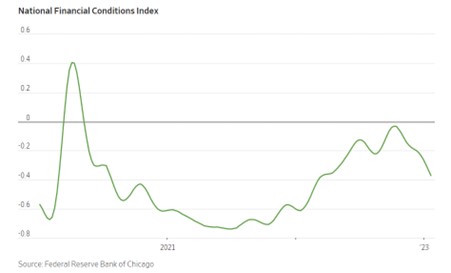By Phil Lucas, Senior Balance Sheet Advisor
The Meeting
Upon the conclusion of the Federal Reserve meeting this week, the committee voted to raise Fed Funds by 25 basis points to a target range of 4.5%-4.75%, the highest level since October 2007. The size of rate hikes has steadily declined from 75 to 50 and now to 25 bps over the last few meetings. In their statement, the Federal Reserve acknowledged that inflation is beginning to ease but remains elevated. The FOMC has guided that it sees the need for “ongoing increases to the target range,” of Fed Funds. This directly contrasts futures contracts which, in the run up to the meeting, had just a single 25 basis point hike priced in for the remaining cycle.
In his interview, Jay Powell acknowledged the divergence in perspectives between markets and the Fed. He attributed the difference to expectations for how quickly inflation will come down. While the Fed welcomes the decline in inflation seen over the last few months, it doesn’t believe that it has identified sufficient evidence of long-term price stability. This indicates that the Fed is looking for additional data points showing a downward trend for inflation, or evidence that inflation is approaching their target of 2%. Based on their current data set, the Fed maintains its position that it will need to keep interest rates higher for longer.
One point of potential anxiety for the Fed comes from the Chicago Fed’s Financial Conditions Index (NFCI). The index is a weighted average of 105 measures of financial activity in categories including risk, credit, and leverage that the Fed can use to see if its monetary policy decisions are having the desired effect. It is showing that financial conditions across markets have loosened, the opposite of what typically happens when the Fed is hiking rates. If looser financial conditions lead to accelerating economic growth, the Fed would have to take rates even higher.

Market Response
Despite the Fed’s stern guidance, the markets initially double-downed on the narrative that the Fed will end up reversing course sooner than they expect. This led treasury yields to initially tumble across the curve. Futures contracts currently indicate a higher than 50% probability of a rate cut by November, signaling that market still believes the Fed will reverse course later this year. Virtually all tenors from 1 month to 1 year are within target Fed Funds range, and all longer-term rates are significantly lower.
The initial reaction was likely fueled by the continuous stream of poor economic data and indicators including declines in personal savings rates, increased loan delinquencies, lay-offs in the tech sector, reduced consumer spending, and poor consumer sentiment. In addition, the ISM New Orders Index, which surveys purchasing managers at 400 industrial companies, hit a key low level last month. Such a low level has never been hit before without a recession following. While the markets look forward for the direction of the economy, the Fed is still looking backward for hard evidence that inflation has been controlled.
However, the move in market rates was quickly reversed on a blowout nonfarm payrolls number on Friday, coming in at an increase of 517,000 jobs, nearly three times the estimate of 187,000. Unemployment fell to 3.4%, the lowest level since the 1960s. In ordinary circumstances, the news would be cause for celebration of a healthy economy, but it also raises concerns that the Federal Reserve has not done enough to sufficiently cool inflation. If we see additional data that indicates economic growth is reaccelerating, the prospects for a pause in rate hikes will certainly diminish. Until economic data forms a consistent narrative, we can anticipate that higher levels of volatility will persist.
Impact on Credit Unions
Higher interest rates for longer would likely benefit many credit unions by allowing us additional time to reprice assets into the higher rate environment, but it may be wishful thinking that the economy can sustain tight monetary policy for much longer. As such, we are likely near the top of this rate cycle, and we’d broadly recommend considering downside scenarios for ongoing strategy. That could include considering longer-term or non-prepayable or non-callable assets, while also trying to keep term liabilities on the shorter side and balancing ongoing risk metrics. Accolade Advisory can help develop a sound balance sheet and investment strategy to support your credit union through economic shifts.